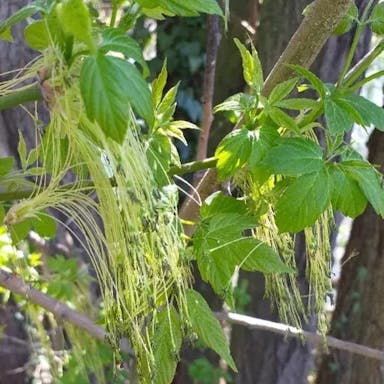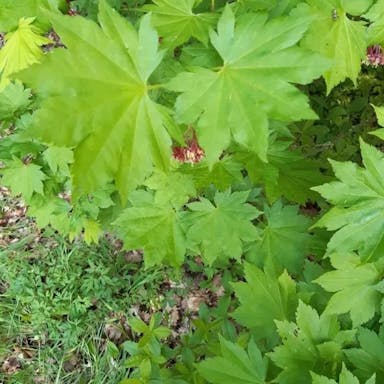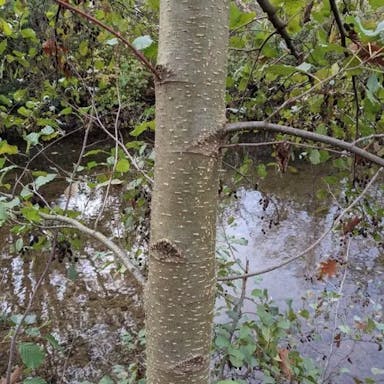Ash-leaf maple, branch of the family Sapindaceae. North America originates and can unfold. The tree characterizes leaves, that compound and resemblance leaves of ash tree, hence common name “ash-leaf maple”. The leaves pinnately compound, with 3-7 leaflets lanceolate shape. They light green color and smooth texture. In terms of flowers, Acer negundo produces small, not noticeable flowers greenish-yellow color. These flowers arranged in groups called racemes, that appear in early spring. The tree monoecious, meaning it has both male and female flowers on same plant. The fruit of Acer negundo is a samara, that is a winged seed that is spread by wind. Acer negundo is a quite fast-growing tree and can reach height of 50-70 feet. It is suitable to broad range of soil conditions and can bear both wet and dry environments. It is commonly used as shade tree and is also planted for ornamental value. However, it can invasive in some areas and may require regular maintenance to control growth. Overall, Acer negundo is versatile tree with unique features that make valuable addition to landscapes and gardens.
Ash-leaf maple
- Scientific name
- Acer negundo
Basic Information
- Sapindaceae Family Acer Genus Ash-leaf maple Species
- Sapindaceae > Acer > Acer negundo
- 83%
- The Completeness of This Encyclopedia
Please help us complete the encyclopedia, Terrarium is a encyclopedia service to be completed with everyone in the world. Currently, this page is 83% complete. For more information on how to contribute, please click here.
- Broad-leaved tree
- Indeciduous tree
- Tree
- Height
- 1000cm ~ 2000cm
- Flower Color
- Leaf Color
- Anthesis
- spring
- Sunlight Exposure
Full Sun Long hours of sunlight from morning to afternoon Partial Shade A location in the shade of a tree or where either the morning or afternoon is shaded Full Shade A place where there is no direct sunlight
- Full Sun
- Hardiness Zones
This is an indicator to know to which zone each plant can winter. Knowing the zone of each plant gives you an idea of the cold temperature resistance when grown in the ground without a roof. 2: -42.7 to -40.0 3: -39.9 to -34.4 4: -34.3 to -28.9 5: -28.8 to -23.3 6: -23.2 to -17.8 7: -17.7 to -12.2 8: -12.1 to -6.7 9: -6.6 to -1.1 10: -1.0 to 4.4 11: 4.5 to 10.0
- 2-9
- Cold resistance
- Excellent
- Heat resistance
- Fair
- Habitat of origin
- United States
- Growth Rate
- Fast
What is Ash-leaf maple (Acer negundo)?
What is Ash-leaf maple (Acer negundo)
Flower meaning
The flower language commonly associated with the Ash-leaf maple plant in America is Reserve. This language signifies a sense of restraint, caution, and holding back. It is often used to convey a message of self-control, prudence, and the ability to wait patiently. The delicate flowers and restrained growth pattern reflect these qualities, making it a suitable symbol for this language. In the language of flowers, each plant or flower carries a specific meaning or sentiment. For example, the rose represents love and passion, while the daisy symbolizes innocence and purity. Similarly, the Ash-leaf maple's language of Reserve conveys a sense of moderation and carefulness. It reminds us to exercise restraint and think before acting, emphasizing the importance of patience and self-discipline in our daily lives.
Calendar of Ash-leaf maple (Acer negundo)
Calendar
Ash-leaf maple, scientifically known as Acer negundo - a deciduous tree native to North America. It typically blooms in the spring season, specifically during the months of April and May. During this time - the tree produces small, inconspicuous flowers arranged in clusters called racemes. The blooming period of Ash-leaf maple usually lasts for a few weeks. To encourage longer blooming - provide the tree with adequate sunlight, water, and nutrients. Prune the tree in late winter or early spring to help promote more vigorous flowering. Note that individual trees may vary in their blooming time depending on factors - climate and growing conditions. Ash-leaf maple produces small flowers for a few weeks in spring if cared for properly.
How to grow Ash-leaf maple (Acer negundo)
Watering
The optimal frequency and method of wetting for the Ash-leaf maple plant depends on various factors, including seasonal variations and soil humidity. During the swelling season, which typically falls in spring and summer, the Ash-leaf maple needs periodic wetting to sustain soil moisture. It is suggested to highly flood the plant one day a week, ensuring that the water pierces the root zone. The quantity of water required can change depending on the size of the plant and the soil species, but a broad guide is to supply about 1 inch of water weekly. In difference, during the inactive season in fall and winter, the Ash-leaf maple needs less frequent wetting. It is main to permit the soil to dry out somewhat between wettings to stop overwatering, which can guide to root decay. A good principle is to water the plant every two to three weeks, or when the top inch of soil feels parched to the touch. Observing the soil moisture grade and tuning the wetting frequency accordingly is crucial for the health and liveliness of the Ash-leaf maple. It is also significant to note that these wetting advice may change depending on the explicit climate and ecological conditions of the plant's point.
Soil and Fertilizer
Ash-leaf maple, Acer negundo, develops properly in diverse dirt situations. It favors adequate drainage system along with a pH array of 6.0 to 7.5. The fertile matter and moisture retention features are crucial. Sandy loam or loamy varieties are exemplary for the plant. To guarantee ideal maturation, it is advised to utilize a balanced additive with a proportion of 10-10-10 or 14-14-14 during the initial spring preceding budding commences. The manure ought to be equally extended surrounding the base, avoiding direct interaction with the trunk. The quantity depends on the dimensions and period, adhering to directions. Throughout maturation, a slow-release fertilizer could be employed each 4-6 weeks to supply steady nutrients. This may proceed until late summer time or early autumn, contingent on the climate. It is vital to thoroughly water subsequent to fertilization to impede root combustion. Frequent soil examination is recommended to observe the pH and nutrient quantities. Adjustments can accordingly be created to preserve ideal conditions.
Sunlight and Place
The name Ash-leaf maple and its scientific name Acer negundo refer to a plant. The moderate cold temperature tolerance of Ash-leaf maple enables it to survive in -20 Celsius winter conditions. However, Ash-leaf maple struggles in places with extremely high heat. 15 to 25 Celsius are optimal temperatures. Shade should protect Ash-leaf maple from intense sunlight in summer. Filtered sunlight or partial shade locations work well. Although Ash-leaf maple survives full sun exposure, more watering assists with preventing sunburn and dryness. At minimum, Ash-leaf maple requires 6 hours of direct sunlight daily. This guarantees proper maturation. However, Ash-leaf maple adapts to various lighting as well. In summary, Ash-leaf maple withstands moderate cold, has limited heat tolerance, and prefers partial shade. A minimum of 6 hours of direct sun enables Ash-leaf maple to thrive.
Advanced Information of Ash-leaf maple (Acer negundo)
Pruning
Ash-leaf maple, scientifically known as Acer negundo, requirements usual cutting and pruning for keeping health. Cutting returns growth and shape. Great occasion pruning Ash-leaf maple during before spring starting, permitting quickly heal avoiding illness. Pruning, making clean slices avoiding stub or harm. Sharp tools avoid illness spread. After, suggest remove debris appropriately. Adding mulch helps wetness, weeds. Check health, growth identify needs. More detail pruning and cutting back Ash-leaf maple, refer good sources like Wikipedia or professional.
Planting and Harvest
Ash-leaf maple, also known as Acer negundo, is a deciduous tree that can be potted or planted in the ground. After potting or planting the tree, it is crucial to provide proper care. The tree requires adequate sunlight and well-draining soil. Overwatering should be avoided to prevent issues like root rot. Repotting every few years in a larger container allows room for growth. Pruning maintains shape and removes problematic branches. Fertilizing at the right times also keeps the tree healthy. With the proper care, the Ash-leaf maple can thrive.
Propagation
Ash-leaf maple is able to spread through various methods like putting seeds, dividing, cuttings, and leaf cuttings. To spread through putting seeds, gather ripe seeds from the tree and put them in a potting mix that drains well. Keep the soil moist and give indirect sunlight. For dividing, carefully dig up the plant and separate the root clumps into smaller sections. Replant the divisions in separate containers or directly on the ground. To spread through cuttings, take 4-6 inch long stem cuttings from a healthy plant. Remove the lower leaves and dip the cut end in a rooting hormone. Plant the cuttings in a potting mix that drains well and keep them in a warm and humid environment. Leaf cuttings can also be used for spreading. Take a healthy leaf and cut it into sections, making sure each section has a vein. Plant the leaf sections in a potting mix and keep them moist. Harvesting can be done when the spread plants have developed strong roots and are ready for moving.
Pests and Diseases
Ash-leaf maple (Acer negundo) is susceptible to several insects and fungal issues. The leaves and branches can be bothered by pests. Pruning away problematic areas may help. There are also problems with spots on the leaves, and the whole plant wilting and dying off. Keeping the tree healthy with proper care can help it fight off issues. Environmental things like too little water can also cause problems. Maple trees can have troubles with insects eating their leaves. This makes holes in the pretty leaves. Watching the tree to find the pests and taking off ruined leaves helps handle this issue. There are fungal sicknesses that hurt maples too. Some make the leaves turn yellow and wilt. Eventually they kill the tree. Removing and throwing out the sick trees prevents spreading it. Another fungus makes spots, leaf loss, and dead twigs. Spring sprays can control that one. Bacteria can also give maple trees leaf scorch. The leaves wilt, get scorched marks, and fall off too soon. More water and fertilizer helps fight this, since there's no cure. Maples can also wither from things like drought, too much heat, or bad soil. Proper water, mulch, and improving the soil prevents these problems.
Habitat of Ash-leaf maple (Acer negundo)
Habitat
Toxicity of Ash-leaf maple (Acer negundo)
Health Benefits
- edible
- Inedible
- Toxic
- No toxicity
NO DATA
Toxic for dogs and cats
NO DATA
Q&A of Ash-leaf maple (Acer negundo)
- Is there a recommended way to choose Ash-leaf maple?
Ash-leaf maple, scientifically known as Acer negundo, is a deciduous tree that belongs to the maple family. When selecting varieties of maple tree, it is important to consider their specific characteristics. The 'Flamingo' variety is known for its variegated leaves, which have boundaries of pink and white. 'Sensation' is selection with variegated leaves, but it has a more subtle coloration. 'Kelly's Gold' is a variety that stands out for its bright lemon foliage. 'Variegatum' is a selection with green leaves that have white margins. When purchasing seeds or seedlings of maple, it is advisable to choose those that are in good health and disease-free. Look for seedlings with well-developed root systems and avoid those with signs of stress or damage. It is also important to ensure that the seeds or seedlings are obtained from a reputable source to guarantee their quality.
0
0












